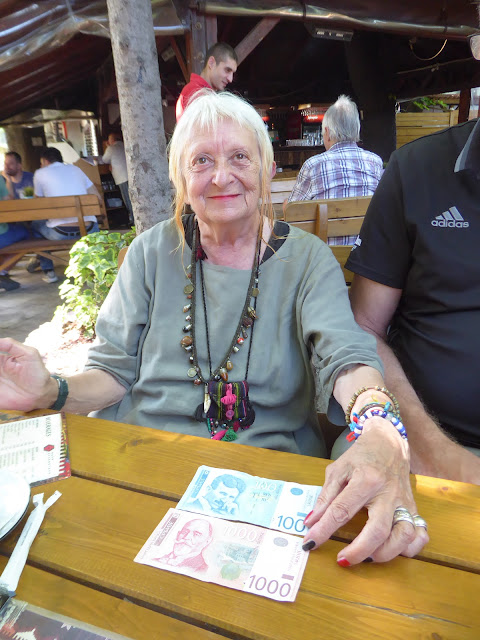We met downstairs at 9.15 after an excellent breakfast. Ivan walked us to the centre of town , where we met with Bojala, our local guide for Belgrade. Bojala showed us around the city and into the main park and fortress area, where we looked down on the confluence of the Danube and Sava rivers and heard the lovely tale of their romance (They agreed to keep on meeting at this location into the future to keep their romance alive) .
 |
| Our local tour guide. |
 |
| entry to the fortress |
 |
| the confluence of the Danube and Sava rivers (what a romance) |
Belgrade lies on the central point in Europe and trade routes from North to South and East to West and has a great position overlooking two rivers on fertile plains. No wonder everyone wanted to own it.
The fortress area has been restyled somewhat and now has basketball courts between the walls, a dinosaur exhibition and also a military museum housed in there. Apparently rock concerts also happen in this area.
 |
| many military machines were on display |
 |
| what is inside this tiny doorway?? |
 | ||||
Oh! A narrow staircase! Where does it go to?
|
There was another area close to where this church is , where people were sitting and resting - at the time we didn't realise why, but I read later that there is a spring of holy water near the church - I assume that this other structure where the people were is where the spring is. The water is said to be particularly beneficial to women (St Petka being the patron saint of women) and to help with sight problems.
When this church was built in 1937, the constructions uncovered a mass grave site of Serbian soldiers from WW1. The bones were moved to a special Ossuary site. We found the Ossuary, set into a corner of the fort wall, just after we left the church, but didn't understand from the signs that the bones had been found on the chapel site.
We gradually worked our way down through the old fortress (past the archeology workshops in the old Roman kitchens and the ancient Charles gate which is still standing,. The old baths had been turned into an observatory.
 |
| Charles gate |
 |
| Archaeology workshop inside the old Roman kitchens |
Further down we reached the river Sava and walked along the river path (also part of a bike route that extends 1100km including from Ljubljana in Slovenia to Belgrade in Serbia.
 We saw all sorts of craft along the river - botched together shacks on floats, barges working hard to move along, fancy cruise boats, lots of nightclub boats on the waters edge.
We saw all sorts of craft along the river - botched together shacks on floats, barges working hard to move along, fancy cruise boats, lots of nightclub boats on the waters edge.Eventually we came to a string of nice looking restaurants. Since it was warm and we needed both a drink and a toilet we decided to pick one at random and stop for lunch and satisfy all our needs.


We had a really delightful lunch looking out at the river and watching life pass on by, before eventually deciding that we had a bit more walking to do to get home, and we had better get on with it.
We strolled home through the major works along the riverbank developing a whole area into swanky new apartments and gardens near where the old railway station used to be, and then through some of the streets not so touristy, and back in to the main shopping area, where we unsuccessfully looked for souvenirs/gifts to take home. Finding nice stuff that is also small and we really want to buy seems to be tricky, so we brought home photos and memories.
After the shopping stop we headed for our hotel (still a couple of km away) for a bit of a rest and freshen up (it is still very hot) before we headed out with the group for tea again.
Walking to tea we went past the statue of Gavrilo Princip (the man who shot Franz Ferdinand and consequently triggered the start of the 1st world war.) Here he is a hero! Franz Ferdinand was from the Imperial Hapsburg dynasty. When he was shot Austria-Hungary declared war on Serbia, thus bringing into place the supporters also (Russia was strong supporter of Serbia).












No comments:
Post a Comment